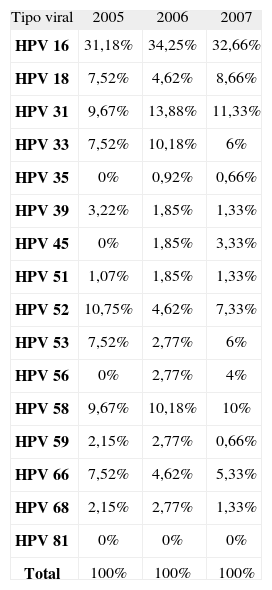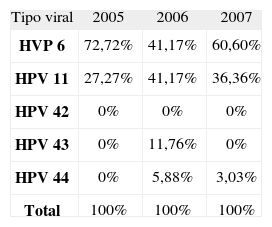El propósito de este estudio ha sido determinar la prevalencia de los tipos de virus del papiloma humano (VPH) implicados en lesiones de cérvix uterino en la Comunidad de Madrid, con dos finalidades: valorar el beneficio que proporcionará la próxima implantación de la vacuna anti-VPH tetravalente (tipos: 6, 11, 16 y 18) y tratar de establecer prioridades para el desarrollo de una segunda generación de vacunas.
Material y métodosSe incluyeron en el estudio 1026 biopsias con lesión de cérvix, recogidas en un periodo de tres años (2005-2007), de las cuales se seleccionaron los casos que cumplieron 3 requisitos: demostración histológica de lesión escamosa intraepitelial (SIL) o carcinoma invasor, presencia de ADN viral por reacción en cadena de polimerasa (PCR) y tipificación de al menos un tipo viral de VPH.
ResultadosDe los 331 casos que cumplían estos 3 requisitos, en el 86% se aislaron virus de alto riesgo y en el 14% de bajo riesgo. Los virus de alto riesgo prevalentes fueron: 16 (34%), 31 (12%), 58 (10%), 33 (8%), 52 (8%), 18 (7%), 66 (6%) y 53 (6%) y los de bajo riesgo: 6 (58%) y 11 (36%). No se observaron variaciones significativas en la distribución de los tipos virales durante los tres años del periodo de estudio.
ConclusionesSin tener en cuenta la posibilidad de reacciones de inmunización cruzadas, la implantación de la vacuna tetravalente en nuestro medio protegería frente al 94% de las lesiones causadas por genotipos de bajo riesgo y frente al 41% de las causadas por genotipos de alto riesgo. Para que la vacunación tenga un fuerte impacto en la carga de la enfermedad y poder prescindir del cribado se necesitarán nuevas vacunas con propiedades mejoradas.
The object of the current study was to determine the prevalence of human papillomavirus (HPV) types associated with uterine cervical lesions in the metropolitan area of Madrid for two reasons: to assess the benefit of impending implementation of the anti-HPV tetravalent vaccine (6, 11, 16 and 18 types) and to attempt to establish priorities for the future development of second generation vaccines.
Materials and MethodsFrom a total of 1026 biopsies from cervical lesions collected in a three year period (2005-2007), 331 specimens were selected that fulfilled the following 3 requirements: histological evidence of squamous intraepithelial lesions (SIL) or invasive carcinoma, presence of viral DNA by polymerase chain reaction (PCR) and the presence of at least one HPV type.
ResultsIt was found that high-risk types were present in 86% of cases, whereas a low-risk type was detected in the remaining 14%. The more prevalent types of high-risk viruses were: 16 (34%), 31 (12%), 58 (10%), 33 (8%), 52 (8%), 18 (7%), 66 (6%) and 53 (6%). Low-risk types were: 6 (58%) and 11 (36%). No significant variations in the distribution of viral type during the three year period of the study were observed.
ConcusionsIt was concluded that, not considering potential cross immunizing reactions, implementation of the tetravalent vaccine in our community would protect 94% and 41% of women against lesions caused by low risk and high-risk genotypes respectively. Therefore, if the purpose of vaccination is to make a strong impact on cervical cancer and avoid screening, new, improved vaccines will be required.
Artículo
Comprando el artículo el PDF del mismo podrá ser descargado
Precio 19,34 €
Comprar ahora












